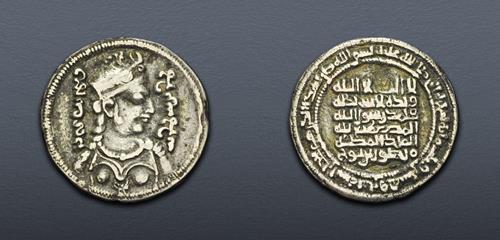|
Samanids. Mansur I b. Nuh. AH 350-365 / AD 961-976. AR Cast Medallion (33mm, 12.07 g, 12h). Bukhara mint. Dated AH 358 (AD 968/9). Obverse margin: bismillah duriba hadha al-dirham bi-Bukhara sanat thaman wa khamsin wa thalath miat hijra nabi salla Allah ‘alayhi
Obverse field:la ilaha illa Allah / wahdahu la sharik lahu / Muhammad rasul Allah / al-Muti‘ lillah / al-malik al-muzaffar / Mansur b. Nuh / Reverse: Royal bust facing left, crowned and armoured, with braided hair down his back; Pahlawi legend xvarrah ‘apzwt - Shahanshah to right and left. Kamoliddin, S., ‘On the Religion of the Samanids’ Ancestors,’ Transoxiana 11 (July 2006), pp. 3-22, p. 13 (illustrating an example in the Ashmolean Museum, Oxford, still apparently unpublished). Toned. VF. Of the highest rarity, believed one of only two specimens known.
The portrait on the reverse of this remarkable piece has extremely close similarities with pre-Islamic medallions issued by the Turkic rulers of Tukharistan, Kabul and Gandhara during the early seventh century AD. Kamoliddin has drawn particular attention to a silver medallion issued by the Turkic ruler Zik (circa AD 610-8) after his victories near Rayy and Isbahan in AD 617/8. The portrait of this piece is very close to that on this Samanid medallion, with a similar crown, long hair similarly braided and flowing down the ruler’s back, and a similar necklace and armour. The Middle Persian legends are also virtually identical (save that the Turkic medallion includes Zik’s name after GDH ‘pzwt ) and even the calligraphy itself is a remarkably close match. It is difficult to escape the conclusion that this Turkic piece served as the prototype for the obverse of this Samanid medallion produced three and a half centuries later.
The prototype for the obverse, however, comes from a more recent source. In AH 351, the Buwayhid ruler Rukn al-Dawla issued medallions of his own at al-Muhammadiya (Rayy), of which examples are known in both silver and bronze. The obverse legends are virtually identical to those on this Samanid medallion, including the exceptional addition of min hijra nabi salla Allah ‘alayhi at the end of the marginal legend; the only differences are the mint, date, and the two lines at the bottom of the field which contain the ruler’s name and titles. Not only are the legends themselves identical, but the calligraphy on both pieces, both Arabic and Pahlawi, appears to be the work of the same engraver, with the elaborate braiding adorning the name of the caliph al-Muti‘ in the fourth line of the field a particular point of resemblance. The reverse of the Buwayhid medallion, meanwhile, depicts a facing Sasanian-style bust, flanked by the same Pahlawi legends GDH ‘pzwt - Shahanshah that we find on the Samanid medallion offered here. Miles considered that this stylised Sasanian bust concealed a representation of Rukn al-Dawla, and it may well be that the image on the reverse of the present medallion likewise bears a portrait of Mansur b. Nuh himself. Kamoliddin notes that the facial features modified on the Samanid medallion have been subtly modified from the Turkic prototype, although other details have been faithfully retained.
Were these two handsome medallions, produced for rulers whose courts were located almost a thousand miles apart, the work of an itinerant medallist? Was this Samanid piece produced as a reaction to the Buwayhid medallion made seven years previously? If so, are we to interpret the choice of its prototype - a piece struck to commemorate a victory over the Sasanians - as a challenge to the Buwayhids, who claimed (albeit spuriously) to be of Sasanian descent? Does this in turn imply that the pre-Islamic Turkic medallion of Zik was still known to the Samanid court at Bukhara in the mid-tenth century Hijri, and its significance understood there? This beautiful and exceptionally rare medallion has much to tell us about how these important dynasties used and adapted the pre-Islamic past in order their heighten their prestige within the contemporary Islamic world.
The final winners of all CNG Islamic Auction 2 lots will be determined during the live sale that will be held on 27 October 2022.
Winning bids are subject to a 22.5% buyer's fee for bids placed on this website and 25% for all others.
We recognize that our users may have various Internet Browsers and Operating Systems. We like our visitors to have the best possible experience when using our bidding platform. However, we do recognize that it is impossible to develop applications that work identically, efficiently and effectively on all web browsers The CNG bidding platform supports the latest stable major version and stable previous version of Chrome and Firefox.
|
